
Jane Street wasn’t my original thinking today. My original plan called for a ride on the PATH train all the way to Newark and then a ride on the Newark Light Rail (formerly City Subway) to Bound Brook Park. But on the weekends, you have to take the PATH to Hoboken first, then Jersey City, and change for a train to Newark. I think I’ll do it midweek when I can get direct service from the Calatrava Oculus downtown.
So, what to do then? I decided to walk Jane Street’s entire length. The Greenwich Village side street slots in between West 12th and Horatio Streets. I then walked north back to Penn Station and got about 4 miles of walking in.
Update: uh oh. I’ve done it already! But I saw a number of things I missed on that walk back in 2019, so here goes.
While its name might sound feminine, Greenwich Village’s Jane Street is not named for a woman (in most cases the wife of a wealthy landowner) like Ann, Hester, or Catharine, further downtown. Instead, the story goes, there was a landowner named Jaynes during the colonial era who would up bequeathing his name to the street.

I began my trip at the west end of the street, literally West Street (house numbers begin at Greenwich Avenue and run west). This is a pedal to the metal 6-lane highway, which was formerly elevated atop the street between 1934 and 1973; the city let it rust and deteriorate so much that a truck fell through it. The West Side (Julius Miller) Highway stood abandoned for about a decade more before it was removed. The Hudson River Park was built along the formerly bustling wharves and docks.
The lampposts and utility poles, one of which is seen here, are painted bright Kelly green; in NYC, lampposts are usually black (for the retro-Corvs and Crooks) or silver/gray (for all the others). However, when the Parks department is mostly running the show, poles can be green, as they are here and in Central Park.

Some of the scaffolding has come off the Jane Hotel.
In 1908, William A. Boring (whose architectural designs weren’t), also the designer of much of Ellis Island’s receiving stations, was behind the drawing boards for what was originally the American Seamen’s Friend Society Institute, meant as visiting sailors’ lodging and as a “temporary refuge” for sailors in distress. The building featured a chapel, concert hall and a bowling alley; a beacon shone to the ships in the Hudson from the top of the tower.
In 1912, the surviving crew from the Titanic were housed here so they would be close to the courts where the inquest regarding the disaster was held. By 1944, the sailors were gone, in a official capacity at least, and the YMCA was running it as an SRO hotel. (Though the 1970s Village People video “YMCA” was filmed on West Street, this wasn’t the YMCA they had in mind; that one was the McBurney on West 14th.)
I have much better photos, including some of the crazy escutcheons, on FNY’s Jane Hotel page.

This neon sign dates back to the Jane’s stint as the Riverview Hotel.
Three blocks of Jane Street are paved with Belgian blocks, between Hudson and West Streets. Greenwich Village still has some (and until the 1980s some main streets around Manhattan as well) but they’ve been disappearing; recently, some in DUMBO, Brooklyn were removed.
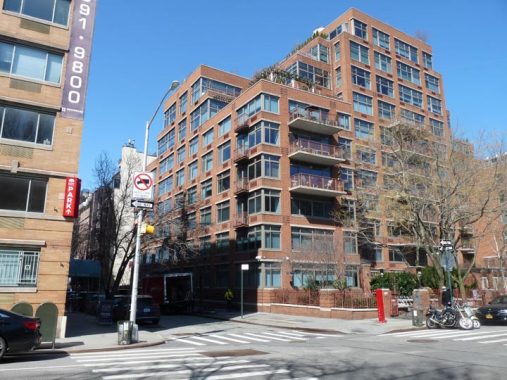
In 1999 the pricey condo complex 99 Jane was built at the NW corner of Washington Street…

In the mid-1980s, long before there was a push to turn the West Side Freight Elevated (the High Line) along Washington Street in the West Village into a park, much of it was demolished: though it originally ran to the old St. John’s Freight RR Terminal near Houston Street, the vast majority south of Gansevoort Street fell to the wreckers’ ball. Here we find a remaining portion of it above Jane Street at Washington.
Vintage photo from Vanishing New York.
Some of the attached brick houses that are the bread and butter of the residential housing in the large Greenwich Village Historic District, on Jane Street between Washington and Greenwich. These Greek revival and Italianate buildings went up between 1845 and 1885. The brick apartment building at #82 was home to firefighter John J. Harvey, who was killed fighting a blaze in an ocean liner at Pier 42. A famed fireboat is named for him.
On a building on this block, Founding Father Alexander Hamilton was taken to recover from his wounds after the fateful duel with Aaron Burr in Weehawken across the Hudson River, but, as you know, he didn’t make it.

Three buildings on the NW corner of Greenwich and Jane, #809-813 Greenwich, were built between 1839 and 1854. All are entered from a courtyard on Jane.
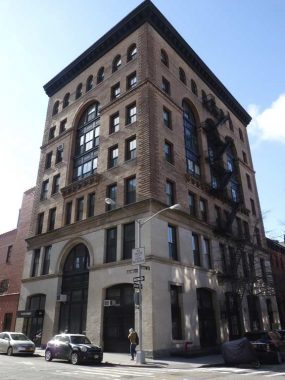
Though its front door is clearly on Greenwich Street a considerable distance from Jane, this former factory building is known as #68 Jane Street. Greenwich Street was completely shrouded by an elevated train in various stages between 1868 and 1940, though you could never tell it was there by looking at the street now.
Because Greenwich Street tends to angle east and west in spots because it originally followed the Hudson River shoreline, there’s not a great distance between Hudson and Greenwich Streets. But the three Greek Revival townhouses built in the 1840s on the south side of Jane, #60, 62 and 64, fill the space well. They retain at least some of their intricate ironwork on the railings and in the case of #64, the entranceway as well.

According to NY Songlines‘ Jim Naureckas, the Italian restaurant at the SW corner of Hudson and Jane, Renato’s Piccolo Angolo (opened in 1992), has been a favorite of Frank Sinatra and baseball’s Mike Piazza, and was used for scenes in the original Richard Roundtree Shaft. In English, the name means “small corner” and reviews say the restaurant is small but the food is excellent.

Tobacconist George Schott had these two handsome brick residences with recessed doorways featuring pilasters (attached columns) built for him in 1846. Schott also built the houses around the corner on Hudson Street; he probably rented them out.

Standing out from its neighbors at #37-39 Jane is this substation built in 1924 for the Edison Electric Illuminating Company. It was converted to apartment buildings in 1966, and windows were added at that time.
Painter Stella Michaels has opened a viewing space at the SE corner of 8th Avenue and Jane Street, in a small wedge between 8th Avenue and West 4th Street. From the window, these works seem to be homages to rock’s David Bowie in his Ziggy Stardust persona and 1950s pinup Bettie Page. This show is running until March 30, 2021. The space was formerly home to Li-Lac Chocolates, founded in 1923 and claimed to be NYC’s oldest chocolatier. Fear not, Li-Lac is a franchise with six other locations.
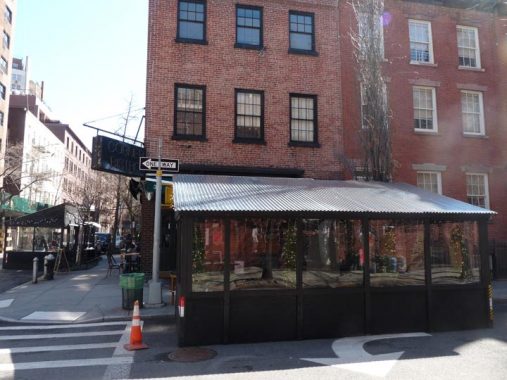
Corner Bistro, at Jane Street and West 4th with a classic neon sign and for now, Covid Pandemic outdoor dining shed. Though a tavern has been in the building since the late 1880s, masquerading as a butcher shop during Prohibition, the restaurant was founded in the 1960s, and has survived because management owns the building. It was the subject of a 1977 New York Times rave review for its burger, still considered among the city’s best. The restaurant gained a new location in Long Island City in 2012; the Pandemic forced its closure in 2020. Prices have been kept down with the classic Bistro Burger checking in at $12.75. A 1940 photo shows that the mast for the neon sign has been there for many years.
#32 Jane Street, a modest two-story dwelling, was built in 1870 and housed a printing concern for several years. Pierre Hardy, the luxe women’ s shoes brand, is the current tenant. On the right is #30 Jane Street, one of the oldest buildings on the block, considerably altered from when it was built in 1829. On the left was Grounded, at #28, a former… coffee shop.
#21-25 Jane Street was built in 1868 for the Bronze Works Manufacturing Company. A gold leaf stencil for the P. E. Guerin Bronze Manufacturers, here since 1892, can be seen on the front windows. It’s amazing that the building has pretty much been home to one industry since it was built.

#24 and 26 Jane Street, apartment buildings constructed in the 1880s. I liked the casement windows on the ground floor.

#22 Jane is this former stable built in 1868. The coachman resided on the second floor, the dobbins on the first.

I had thought that the modernist exterior of #16 Jane had been done relatively recently, somehow getting around the Landmarks Preservation Commission rules about renovating exteriors, but no, it looks essentially the same as it did in 1940, with the fire escape ironwork resembling dominos. The building goes all the way back to 1887, with the Moderne re-do in 1939. The report says a pair of murals by Tony Sarg (who designed the original Macy’s Thanksgiving Parade balloons in the 1920s) could be found in the lobby, but only a portion of one survives.
Plots are so tight in the Village that occasionally, you will find houses to the rear of other buildings, known in the architectural trade as “backhouses.” This one, in back of #9, is #9-1/2 Jane Street. #9 was built in 1844, with #9-1/2 ten years later.
#5-7 Jane Street is a rather large apartment building in the Italianate style built in 1871. A mystery for me is the addresses rendered over the front entrances, which say 5 and 5-1/2 and 7 and 7-1/2. Who lives at the half addresses in the buildings?

I have always wanted to get something at A Salt and Battery on Greenwich Avenue just across from Jane, but never have. Fish & chips is one of my favorites. When I visited the Land of My Ancestors in Newfoundland in 1986, I had two fish and chip meals. One was just OK but the other was transcendent. Closer to home, the old man and I would preorder the fish and chips on Fridays from a seafood restaurant on 4th Avenue that had a fish store next door. I would go pick it up in the days before seamless or doordash. For me, the crispier the better, I am not a soft batter person.
There seems to be a mini-British settlement around this part of the Village; next door is Tea & Sympathy, and a few blocks away is Meyers of Keswick.
Check out the ForgottenBook, take a look at the gift shop, and as always, “comment…as you see fit.”
3/21/21


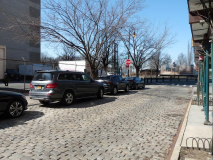
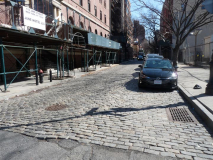
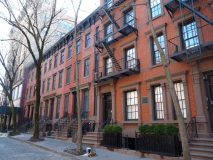
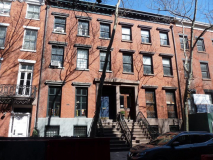
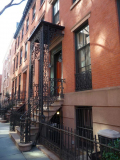
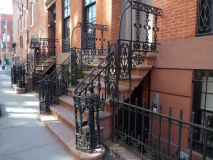
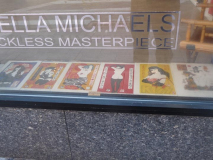
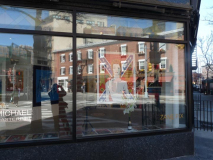
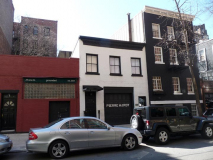
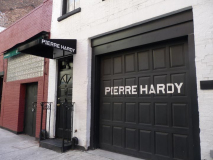
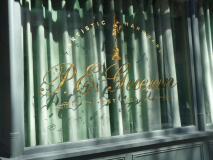
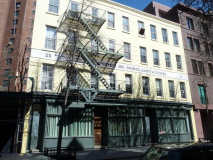
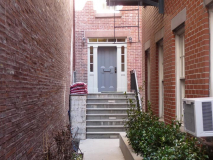
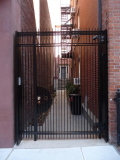
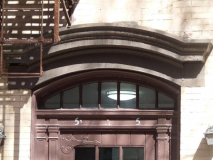
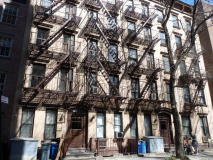
13 comments
It’s a direct train from WTC to Newark on weekends; only the 33rd- Journal Square train stops at Hoboken.
True, but I didn’t want to ride all the way downtown from Penn.
According to the Department of Finance tax map 5, 5 1/2, 7, and 7 1/2 Jane Street are actually 4 separate buildings. Curious as to how the pairs work together internally.
Back in the mid 80s the ballroom of the Jane St. hotel was called the Rock Hotel and used to feature a lot of hardcore punk rock bands. A few I remember seeing: Bad Brains, D.O.A, and GBH.
Just curious, the article says that the McBurny YMCA is on 23rd street, yet it is currently on 14th street. Did it move or is this a typo?
Fixed.
“a ride on the Newark Light Rain”
who doesn’t enjoy a little light rain?
All right, you got me. Fixed.
The owner of A Salt & Battery should realize that his establishment has been “assaulted” by tagger vandals which is neither humorous nor ironic.
Re: Backhouses
How often are backhouses exposed when the fronthouses are demolished, and the backhouses are allowed to remain, exposed to public view from the street? I know of very few cases. I think one such case is on Fairmount Avenue in the McGinley Square Jersey City neighborhood. Even rarer, when the backhouses are exposed, are there cases of new buildings being built in front of the undisturbed backhouses, so the latter are allowed to go back into hiding undisturbed?
When I worked at the WTC in high school after work(1974) I would sometimes go up on the old west side hwy
on my way home.So dark, quiet and peaceful up there,no cars or pedestrians to contend with.
Like having my own private sidewalk and what a view!Then I would have to get off at 42nd st.
because I lived on the east side and have to start cutting across town.
So Grounded is gone? During one of our extended NYC visits, my wife and I went there upon recommendation from a friend who knows all the great coffee places in NYC. I’ll have to ask her if she knows about the closing.
Beautiful part of NYC. The few homes with carriage houses that can be used as garages command top dollar.